Xin Q. Diesel Engine System Design
Подождите немного. Документ загружается.

468 Diesel engine system design
© Woodhead Publishing Limited, 2011
can be used to assist DPF regeneration. However, there are challenges on
the post injection timing. Too early post injection may cause difculty in
engine torque control, while too late post injection may cause oil dilution
or bore-washing problems.
Engine system design is closely related to the following fuel system
areas:
∑ the effect of the conventional diesel fuel properties on engine performance,
emissions, and durability
∑ alternative-fuel and dual-fuel diesel engine performance and durability
∑ life cycle cost and benet analysis for the alternative-fuel and dual-fuel
engines
∑ the effect of fuel injection on engine performance, combustion, emissions,
and noise; and the strategy of the required fuel injection rate prole
∑ fuel injection spray characteristics
∑ fuel injection system hydraulic dynamics for the predictive modeling of
fuel injection rate shape and engine system optimization
∑ parameterization of fuel injection rate proles for the engine steady-state
and transient cycle simulations
∑ fuel system parasitic power losses, heat rejection, and the impact on
engine BSFC and vehicle fuel economy
∑ injector tip temperature and injector coking
∑ real-time modeling of fuel system hydraulic dynamics for hardware-
in-the-loop controls development (Woermann et al., 1999; discussed in
Chapter 14)
∑ fuel delivery unevenness detection and misre detection, and their model-
based controls based on system performance and dynamics parameters
(Macián et al., 2006; discussed in Chapter 14)
∑ model-based fuel path and governor controls (e.g., engine speed control
for better stability and drivability; discussed in Chapter 14).
Engine cycle simulation is closely related to fuel system design and
matching. The fuel injection rate prole used in the engine cycle simulation
can be estimated empirically based on the fuel system bench test data or
the hydraulic/dynamic simulation data. Fuel spray can be simulated to
predict the air entrainment, the evaporation and the combustion by using
the phenomenological or KIVA models. The effects of fuel system design
and combustion bowl matching on fuel spray pattern, heat release and air
utilization in the cylinder can be analyzed. The injector tip temperature is
affected by the in-cylinder gas temperature, the heat ux, and the fuel ow
rate. Injector coking is directly affected by the metal temperature and the
additives in the fuel. The engine cycle simulation in system design may
provide the simulated thermal boundary conditions for the cylinder head and
the injector in the entire engine speed–load domain under different operating
Diesel-Xin-07.indd 468 5/5/11 11:51:26 AM
469Combustion, emissions, and calibration for system design
© Woodhead Publishing Limited, 2011
conditions. This can help develop engine control algorithms to alleviate the
injector coking problem.
The ability of diesel fuels to lubricate the fuel injection components
is referred to as its lubricity. Fuel lubricity (SAE J2265, 1995; Matzke et
al., 2009) and wear durability of the fuel system is mainly a component
design issue. However, the impact of lubricity additives in the diesel fuel
on engine emissions and aftertreatment performance should be considered
at the system design level. Modern fuel systems offer very high injection
pressures and hence the loaded tribological contact conditions in the fuel
injection equipment will become more severe.
The following literature on diesel fuels and fuel systems can help an engine
system design engineer to acquire the necessary knowledge of fuel system
selection and matching. The chemistry of diesel fuels is introduced by Oven
and Trevor (1995) and Song et al. (2000). Diesel fuel properties are reviewed
by Batts and Zuhdan-Fathoni (1991), Majewski and Khair (2006), Ribeiro et
al. (2007), and Matzke et al. (2009), and also explained in SAE J313 (2004)
and J1498 (2005).
The effects of diesel fuels on emissions are reported by Den Ouden et al.
(1994), Singal and Pundir (1996), Nylund et al. (1997), Boesel et al. (2003),
Matthews et al. (2005), Kono et al. (2005), Hara et al. (2006), Zannis et al.
(2008), Fanick (2008), Nanjundaswamy et al. (2009), and Hochhauser (2009).
The sulfur impact on diesel emissions control is reviewed by Corro (2002).
Diesel fuel system design and performance are summarized by Cuenca (1993),
Gill and Herzog (1996), Bauer (1999), Stan (1999) and Zhao (2010).
The fundamentals of fuel injection system dynamics are introduced by
Marcic (1993, 1995). Advanced simulation models of fuel injection system
dynamics are developed by Kouremenos et al. (1999), Desantes et al. (1999),
Yamanishi (2003), Gullaksen (2004), Mulemane et al. (2004, with the software
AMESim), and Kolade et al. (2004, with GT-FUEL). The models were able
to predict the fuel injection pressure, the needle lift, the injection ow rate
shape, the hydraulic pressure uctuation in the system, and the fuel spray
condition at the nozzle exit. A Design-of-Experiments (DoE) simulation
analysis applied to fuel injection system dynamics was presented by Amoia
et al. (1997). Fuel injection system instability and cavitation were studied by
Ficarella et al. (1999) with dynamic modeling. The effects of the geometry of
the rail-to-injector connection pipe on the injection pressure oscillation and
the injection rate in a common rail system were experimentally investigated
by Beierer et al. (2007).
Simplied uid dynamics models may produce substantial errors in fuel
injection pressure and rate predictions if fuel cavitation in the high pressure
system and the variations in bulk modulus with temperature and pressure are
not considered (Lee et al., 2002). Fuel spray behavior and injector nozzle
ow cavitation are reviewed by Schmidt and Corradini (2001).
Diesel-Xin-07.indd 469 5/5/11 11:51:26 AM
470 Diesel engine system design
© Woodhead Publishing Limited, 2011
7.2.4 Combustion chamber design
In direct injection diesel combustion system design, the combustion chamber
shape and the engine compression ratio are important for in-cylinder air motion
and emissions. The compression ratio has a direct impact on system design
because it affects unaided cold start, peak cylinder pressure at the full load,
the allowable air–fuel ratio and EGR rate, friction losses and mechanical
efciency, emissions, engine cycle indicated thermodynamic efciency, and
BSFC. For low emissions and low fuel consumption the heat release rate
during the premixed combustion phase needs to be reduced in order to lower
the combustion temperature and reduce the NO
x
emissions (for example, by
using pilot injection). The heat release rate during the diffusion combustion
phase needs to be raised in order to keep fast combustion rate and a proper
in-cylinder temperature to reduce the HC, the CO, and the PM. The late
stage of the diffusion combustion phase needs to be shortened in order to
reduce the fuel consumption and the exhaust temperature.
Key issues in combustion design include the following:
1. The engine compression ratio needs to be selected to ensure acceptable
peak cylinder pressure and reliable unaided cold start. During the cold
start, self-ignition is achieved by a combination of sufcient time and the
required temperature (Gardner and Henein, 1988). They are affected by a
number of factors, including compression ratio, ambient temperature, fuel
injection amount and timing, starting speed, the speed-related gas leakage
past the piston rings and heat transfer losses, and other starting aids (e.g.,
excess fuel injection, glow plug, heaters, and ether). A low compression
ratio causes a reduction in engine thermodynamic cycle efciency and
possibly undesirable increase in the ignition delay. Note that the indicated
fuel conversion efciency of the constant-volume cycle is
h
th
= 1 – W
1–k
7.1
where W is the compression ratio and k is the ratio of the specic heat
capacities, k = c
p
/c
v
> 1. An excessively high compression ratio results
in increased mechanical friction and higher NO
x
emissions. When intake
valve closing timing is changed, the ‘effective’ engine compression
ratio may vary although the effect is not exactly the same as changing
the geometric compression ratio. In general, a high compression ratio
is better for low HC emission at the low-speed, low-load operation. At
high speeds or high loads, a low compression ratio may reduce smoke
and fuel consumption via calibration changes.
2. The combustion chamber design needs to match the high-pressure fuel
injection system and the intake swirl for good mixing. The combustion
chamber shape variation along the radial or the axial direction controls
the swirl, the vortex, and the turbulence of the in-cylinder airow and
Diesel-Xin-07.indd 470 5/5/11 11:51:27 AM
471Combustion, emissions, and calibration for system design
© Woodhead Publishing Limited, 2011
the wall impingement of the fuel spray to achieve better air utilization
and reduce the air–fuel ratio required.
3. Optimum swirl intensity has a tendency to decrease so that the design
of a more quiescent combustion bowl with a higher injection pressure
is more favored for low to medium speed engines. Wall impingement
of the fuel spray should be generally avoided in the design. Low swirl
leads to low turbulence in the combustion chamber, resulting in low
heat rejection through the wall of the combustion chamber.
4. A low surface-to-volume ratio is preferred in order to minimize the heat
rejection losses (Siewert, 1978; Filipi and Assanis, 2000).
5. The metal temperature at the edge of the combustion bowl is related to
the bowl shape. It needs to be optimized for the best trade-off between
the airow turbulence enhancement and the thermal fatigue life.
6. The combustion noise may be reduced by turbocharging and fuel injection
strategies through a reduced rate of increase of the cylinder pressure. The
combustion noise can also be reduced by the attenuation of structural
damping. This topic is discussed in more detail in Chapter 11.
More information about diesel engine combustion chamber design can be
found in Hikosaka (1997), Lu et al. (2000), Montajir et al. (2000), Mori et
al. (2000), Bianchi et al. (2000), Regueiro (2001), Wickman et al. (2001),
and Cursente et al. (2008). Diesel cold start performance was investigated
by Gonzalez et al. (1991), Mitchell (1993), Liu et al. (2003), Zhong et al.
(2007), Peng et al. (2008), MacMillan et al. (2008), and Pacaud et al. (2008).
Variable compression ratio (VCR) engines have been researched by Roberts
(2003), Rabhi et al. (2004), Hountalas et al. (2006), Tomita et al. (2007),
Tsuchida et al. (2007), and Gérard et al. (2008).
An engine cycle simulation is presented in Fig. 7.2 to illustrate the
effect of start-of-combustion (SOC) timing and EGR rate on engine system
performance. Figure 7.3 shows the simulation result of the effect of combustion
duration on engine performance at peak torque and rated power. Figure 7.4
illustrates the effects of the rise rate and the duration of the heat release
rate on exhaust manifold gas temperature and coolant heat rejection. It is
found that the initial reduction of the coolant heat rejection is caused by a
reduction in the in-cylinder heat transfer as the heat release rate duration
is stretched longer. As the combustion duration increases further, the nal
sharp increase in the coolant heat rejection is due to the much higher fueling
rate required to maintain the same rated power caused by the large increase
in the BSFC.
7.2.5 Fundamental combustion/emissions test and air
system requirement
Either single-cylinder or multi-cylinder engine emissions experiments can
be conducted in order to determine the combustion recipe and the air system
Diesel-Xin-07.indd 471 5/5/11 11:51:27 AM
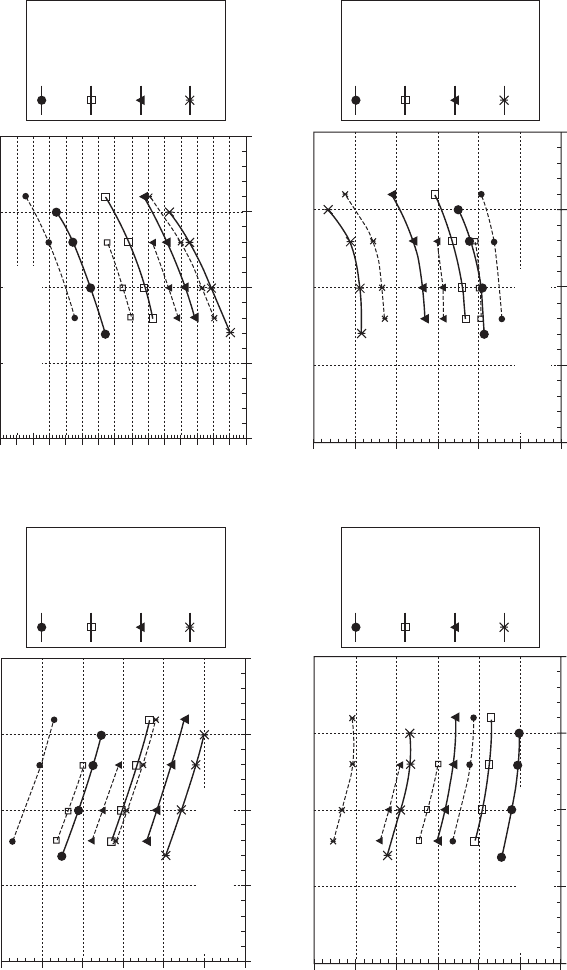
© Woodhead Publishing Limited, 2011
1900 rpm, A/F = 26 for 330 hp and A/F = 24 for 370 hp
1900 rpm, A/F = 26 for 330 hp and A/F = 24 for 370 hp
1900 rpm, A/F = 26 for 330 hp and A/F = 24 for 370 hp
1900 rpm, A/F = 26 for 330 hp and A/F = 24 for 370 hp
Solid curves: 330 hp
Dotted curves: 370 hp
Solid curves: 330 hp
Dotted curves: 370 hp
Solid curves: 330 hp
Dotted curves: 370 hp
Solid curves: 330 hp
Dotted curves: 370 hp
0 5 10 15 20
EGR rate (%)
0 5 10 15 20
EGR rate (%)
0 5 10 15 20
EGR rate (%)
0 5 10 15 20
EGR rate (%)
SOC = 10
deg BTDC
SOC = 7
deg BTDC
SOC = 4
deg BTDC
SOC = 1
deg BTDC
SOC = 10
deg BTDC
SOC = 7
deg BTDC
SOC = 4
deg BTDC
SOC = 1
deg BTDC
SOC = 10
deg BTDC
SOC = 7
deg BTDC
SOC = 4
deg BTDC
SOC = 1
deg BTDC
SOC = 10
deg BTDC
SOC = 7
deg BTDC
SOC = 4
deg BTDC
SOC = 1
deg BTDC
Peak cylinder gas temperature
(°F)
Exhaust manifold gas temperature
(°F)
BSFC (lb/(hp.hr))
Peak cylinder pressure (psia)
3000
2900
2800
2700
2600
2500
2400
1200
1150
1100
1050
1000
950
900
0.38
0.37
0.36
0.35
0.34
0.33
0.32
3500
3400
3300
3200
3100
3000
2900
2800
2700
2600
2500
2400
2300
2200
2100
2000
7.2 DoE simulation of the effect of start-of-combustion (SOC) timing and EGR rate.
Diesel-Xin-07.indd 472 5/5/11 11:51:27 AM
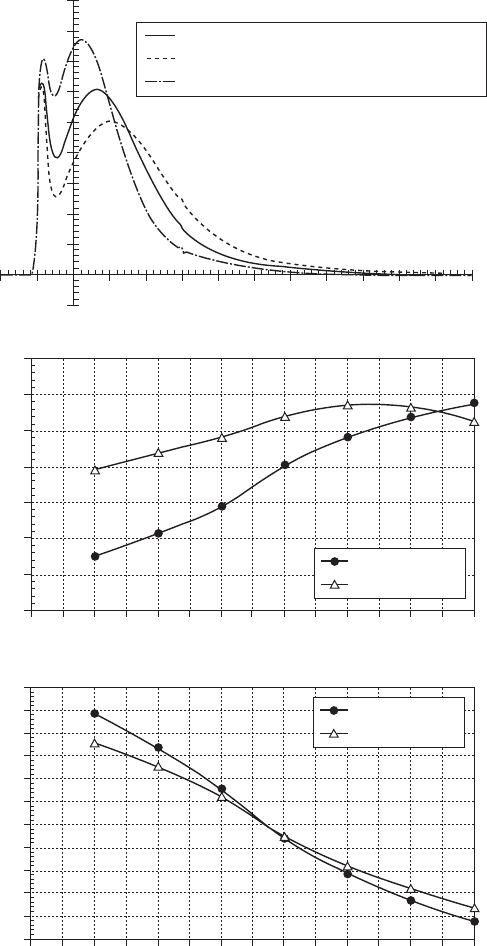
473Combustion, emissions, and calibration for system design
© Woodhead Publishing Limited, 2011
–20 –10 0 10 20 30 40 50 60 70 80 90 100 110
Crank angle (degree)
0.045
0.040
0.035
0.030
0.025
0.020
0.015
0.010
0.005
0.000
–0.005
Normalized apparent heat release
rate (1/degree)
At rated power 2000 rpm 470 hp
Heat release rate duration multiplier = 0.8
Heat release rate duration multiplier = 1
Heat release rate duration multiplier = 0.6
A/F ratio
Percentage of fuel energy lost to base
engine coolant heat rejection
22
21
20
19
18
17
16
15
29
28
27
26
25
24
23
22
21
20
19
18
Peak torque
Rated power
Peak torque
Rated power
0.0 0.1 0.2 0.3 0.4 0.5 0.6 0.7 0.8 0.9 1.0 1.1 1.2 1.3 1.4
Heat release rate duration multiplier
0.0 0.1 0.2 0.3 0.4 0.5 0.6 0.7 0.8 0.9 1.0 1.1 1.2 1.3 1.4
Heat release rate duration multiplier
7.3 Simulation of the effect of heat release rate duration on engine
performance (non-EGR high-power-density diesel engine).
Diesel-Xin-07.indd 473 5/5/11 11:51:27 AM
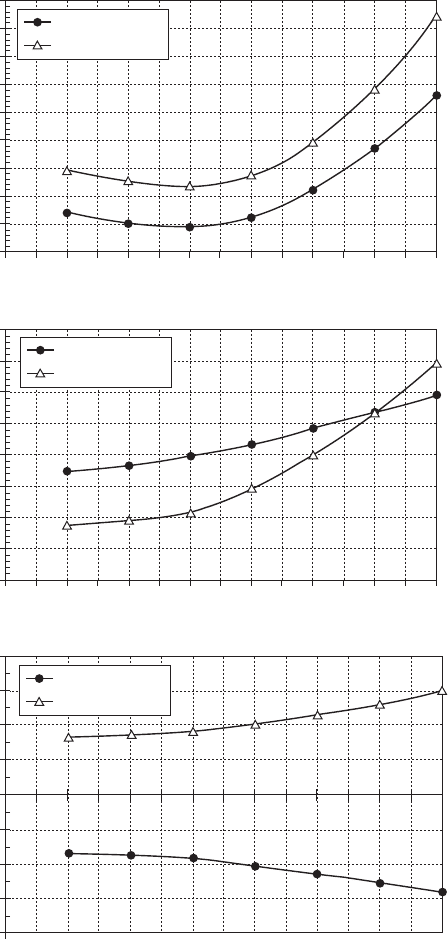
474 Diesel engine system design
© Woodhead Publishing Limited, 2011
Peak torque
Rated power
Peak torque
Rated power
Peak torque
Rated power
0.0 0.1 0.2 0.3 0.4 0.5 0.6 0.7 0.8 0.9 1.0 1.1 1.2 1.3 1.4
Heat release rate duration multiplier
0.0 0.1 0.2 0.3 0.4 0.5 0.6 0.7 0.8 0.9 1.0 1.1 1.2 1.3 1.4
Heat release rate duration multiplier
0.0 0.1 0.2 0.3 0.4 0.5 0.6 0.7 0.8 0.9 1.0 1.1 1.2 1.3 1.4
BSFC (lb/(hp.hr))
Exhaust manifold gas temperature (°F)
Engine delta P (back minus boost, mbar)
BSFC (lb/hp.hr)
0.43
0.42
0.41
0.40
0.39
0.38
0.37
0.36
0.35
0.34
1600
1550
1500
1450
1400
1350
1300
1250
1200
800
600
400
200
0
–200
–400
–600
–800
Heat release rate duration multiplier
7.3 Continued
Diesel-Xin-07.indd 474 5/5/11 11:51:28 AM
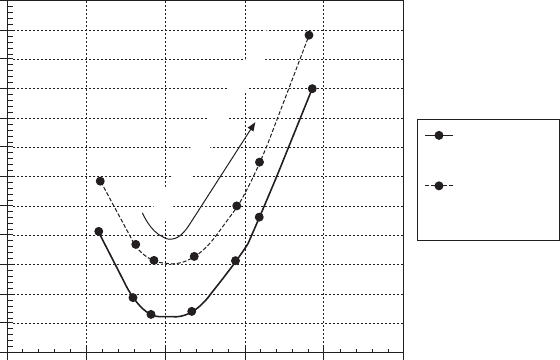
475Combustion, emissions, and calibration for system design
© Woodhead Publishing Limited, 2011
requirement at the minimum engine delta P (pumping loss) and BSFC. At a
given speed and torque, the air–fuel ratio and EGR rate required to meet the
target emission requirements are contingent upon the BSFC produced in the
test. Therefore, the engine delta P and the BSFC used in the emissions recipe
test need to be as close to their respective optimums as possible. In the test,
the EGR circuit hardware needs to be selected with the lowest possible ow
restriction for the EGR cooler and the EGR valve. Hardware screening with
the DoE method can be conducted by both the KIVA simulation and engine
testing in order to select the optimum compression ratio, combustion bowl
design, intake swirl ratio, and fuel injector nozzle design. Then, the DoE
tuning test may be conducted at the critical speed–load modes used for the
heavy-duty emissions certication. In the single-cylinder engine test, the DoE
factors are intake manifold gas temperature (varied by EGR or charge air
cooling), intake manifold pressure, exhaust manifold pressure, EGR valve
opening, fuel injection timing and pressure. In the multi-cylinder engine
test, the DoE factors are the same except for using the VGT vane opening
or the turbine wastegate opening to replace the intake manifold pressure,
and using the exhaust restriction setting to replace the exhaust manifold
pressure. Intake throttle valve opening is an optional DoE factor that may
be used near the peak torque region to drive the EGR ow or used in the
high-speed, low-load region to largely reduce the air–fuel ratio in order to
reduce the NO
x
. The intake throttle may also be used to achieve the low
Engine coolant heat rejection (Including
EGR cooler heat rejection, Btu/min)
8700
8600
8500
8400
8300
8200
8100
8000
7900
7800
7700
7600
7500
Rated power, A/F = 23, EGR = 20%, fixed fuel injection timing
Longer combustion duration
Slower heat
release rate
Steeper
(faster) heat
release rate
800 900 1000 1100 1200 1300
Exhaust manifold gas temperature (°F)
7.4 Effect of combustion heat release rate on exhaust temperature
and coolant heat rejection.
Diesel-Xin-07.indd 475 5/5/11 11:51:28 AM
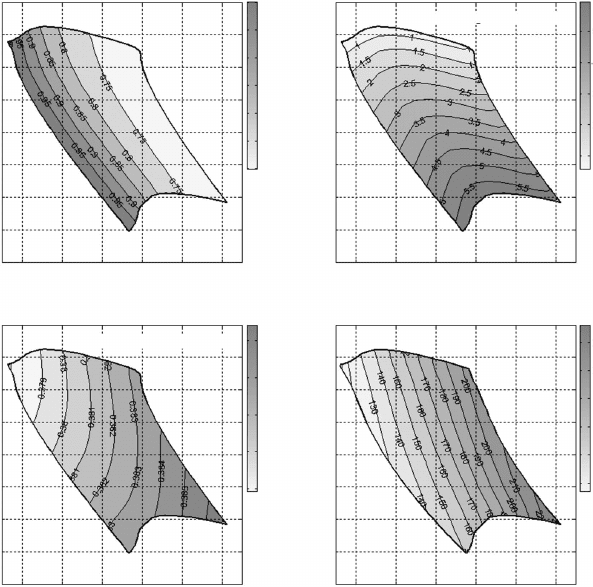
476 Diesel engine system design
© Woodhead Publishing Limited, 2011
minimum ow rates for smooth engine shutdown with a minimum NVH, or
used in the fuel-rich regeneration of a NO
x
adsorber. More DoE factors may
be included for more exible air systems (e.g., variable valve actuation).
Those DoE factors are very similar to those used in the production engine
calibration stage.
Before running the multi-cylinder engine test, in order to check whether
the test can cover a desirable range of EGR rate and air–fuel ratio, the
capability of the available turbocharger hardware needs to be checked by
an engine cycle simulation through sweeping the VGT vane or the turbine
wastegate opening, the exhaust restriction, or the intake throttle opening.
The parametric sweeping simulation data in Fig. 7.5 illustrate how to build
a sufciently wide and controllable range of air–fuel ratio and EGR rate in
such a fundamental emissions test. Note that each data point in Fig. 7.5 can
220
200
180
160
140
120
5
4
3
2
1
1
0.95
0.9
0.85
0.8
0.75
0.7
0.386
0.384
0.382
0.38
0.378
24
23
22
21
20
19
18
17
16
24
23
22
21
20
19
18
17
16
24
23
22
21
20
19
18
17
16
24
23
22
21
20
19
18
17
16
A/F ratio
A/F ratioA/F ratio
A/F ratio
1 inch Hg = 0.033864 bar
1 lb/hp.hr = 608.3g/kW.hr
VNT vane opening (–)
BSFC (lb/(hp.hr)) Engine delta P (mbar)
Turbine wastegate fully closed, EGR valve fully open, intake throttle valve fully open
Exhaust restriction pressure drop (inch Hg)
28 30 32 34 36 38
EGR rate (%)
28 30 32 34 36 38
EGR rate (%)
28 30 32 34 36 38
EGR rate (%)
28 30 32 34 36 38
EGR rate (%)
7.5 Effects of turbine area and exhaust restriction at rated power.
Diesel-Xin-07.indd 476 5/5/11 11:51:28 AM
477Combustion, emissions, and calibration for system design
© Woodhead Publishing Limited, 2011
be solved by using the equations in Chapter 4. If the air–fuel ratio is too low,
the exhaust restriction pressure drop can be articially lowered. If the EGR
rate is too high with the VGT (VNT) vane fully open, a turbine wastegate
passage can be built in the test or cell to reduce the engine delta P in order
to reduce the EGR rate.
After the test data are obtained, DoE emulators need to be built and an
optimization needs to be conducted to compute the engine performance
contour maps as shown in Fig. 7.6. The parameters on the contour maps
usually include EGR rate, air–fuel ratio, intake manifold gas temperature,
fuel injection timing and pressure, engine delta P, BSFC, and combustion
noise. The required emissions recipe for a given emissions target of NO
x
, PM,
HC, and CO can be found in the ‘PM or soot vs. NO
x
’, ‘PM vs. NO
x
+HC’
or the ‘air–fuel ratio vs. EGR rate’ domains. In order to address the possible
differences in turbocharger efciency and EGR circuit restriction in a future
design stage, two sets of contour plotting are useful: (1) an ideal situation with
the EGR valve set at fully open, which produces the minimum engine delta
P (pumping loss) and BSFC; (2) a more practical or deteriorated situation
with the EGR valve set at partially open, which produces a higher pumping
loss. The degree of EGR valve throttling depends on speed, torque, turbine
area, and turbocharger efciency.
The above emissions test may also be conducted to mimic the high-altitude
and hot-ambient emissions performance for the NTE emissions requirements.
The DoE data of the extreme ambient conditions can be processed using
the same approach to obtain the air system requirements for NTE. During
the process of determining the combustion/emissions recipe, the correlation
between the steady-state and the transient emissions with proper engine control
strategies should be factored in. These air system functional requirements of
air–fuel ratio, EGR rate, and intake manifold gas temperature are then sent
to the system design engineer. Note that this combustion/emissions recipe is
associated with a certain heat release rate and start-of-combustion timing and
BSFC, as well as certain assumptions in the combustion–fuel system matching
used by the combustion engineer. Engine system design specications are
then computed and optimized by the system engineer for hardware sizing
of the turbocharger, the EGR circuit ow restriction, and the cooler size.
The lower the air–fuel ratio and the EGR rate required for combustion, the
easier the air system design. It should be noted that multiple turbochargers
or cooling congurations may reach the same air system functional target.
However, it is the system analysis engineer’s responsibility to optimize the
hardware selection. An example of combustion development can be found on
Navistar’s model year 2004 6.0 L V8 engine (Zhu et al., 2004). A procedure
of engine air system design based on combustion/emissions requirements is
illustrated in Fig. 7.7.
It should be noted that engine system design often needs to translate the
Diesel-Xin-07.indd 477 5/5/11 11:51:28 AM
